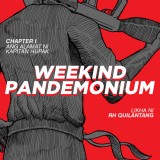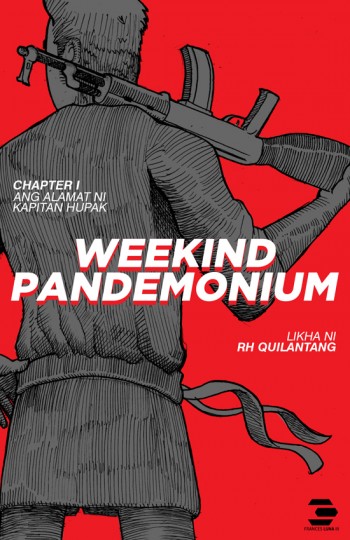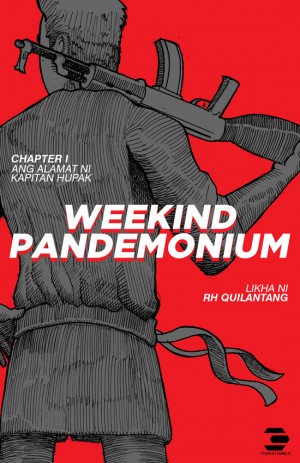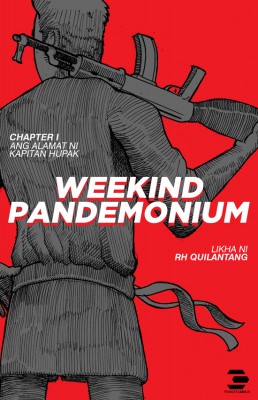
COMIC BOOK REVIEW: Weekind Pandemonium, Chapter 1: Ang Alamat ni Kapitan Hupakto
PROUD TO BE GEEKS RH Quilantang’s latest venture of comic adventure, Weekind Pandemonium: Chapter 1: Ang Alamat ni Kapitan Hupakto, is a testament of his love of anything and everything pop culture, past and present. It is also his inner passion to illustrate the connectivity of these references into one cohesive tale of misadventure without missing a […]
RH Quilantang’s latest venture of comic adventure, Weekind Pandemonium: Chapter 1: Ang Alamat ni Kapitan Hupakto, is a testament of his love of anything and everything pop culture, past and present. It is also his inner passion to illustrate the connectivity of these references into one cohesive tale of misadventure without missing a beat of sheer visceral power/prowess, especially in regards of his imagination, I mean. Quite appropriately, his opening salvo serves as a good jumpstart to his expanding universe, some interesting and wacky characters, and the evolution of his overall artistic execution, as well.
Quilantang applies a couple of non-linear storytelling tropes in Ang Alamat ni Kapitan Hupakto create an air of suspense and a bit of mysteriousness, particularly on the mind-boggling end part and the underlining forces prior of the conflict. He reveals some parts of the mystery, but the true motives and the factors behind these are still cleverly hidden or unraveling, making (or so, obliging) readers to wait for more stuffs (yes, this 101 page graphic novel is a hors d’oeuvre). Henceforth, one can make a couple of speculations or theories on fleshing out the mysterious auras behind the trump card of the stories’ so-called counterparts. Furthermore, the creator introduces the casts and the respective groups they are respectively aligned, namely “Tanod”, “Karpentero”, and “Removers”. Aside the former, readers are played of deciphering which of two latter packs are the underdogs and/or oppressors for imagination is part of the reading experience here, especially in the last section of this visual literature. Thus, pacing is required here.
The paneling and the sequences are primarily accessible since the story demands to be read with deliberate pace, regarding on the dialogues and the interactions of the entire cast. The absence of bombastic and over-the-top splash pages is commendable because they can be serious hindrances of the narrative flow and the already dense script. Many panels present the creator’s brand of cross-hatches to compensate the absence of coloring here, creating an illusion of the greater sense of ambiance and/or tensions on some characters, most of the time during serious and some dramatic scenes. Moreover, the author’s utilization of executing some iconic and popular references in our geek-collectiveness are most probably his strongest narrative aces in the entire story. The most prominent in delivering homage is the beginning and the confrontational sections, where the 1970s up to the 1990s readers and/or fans of several beloved television series that usually presented gestalt gigantic and mechanical robots around. Personally, I can hear these iconic lyrics when I read some of the abovementioned lines containing or signifying the said tributes. His comic book is truly a work of cleverness, with occasional naughtiness, if not humor.
Regardless, reading this is virtually akin of experiencing the latest James Bond film – Spectre. For the record, I finished, analyzed, reflected, and reconstructed after reading this one without missing a beat, aside from very minor details. So, the flow or pace of the story is dragging to the middle part of this work, only to experience some serious smack down or the “pandemonium” thing later on. I personally acknowledge the author’s application of the vernaculars since we should be the target demographics first and foremost. But the same interactions are often littered with street lingos that on the personal level can be hard to comprehend unless I reread these said lines twice to thrice back. Furthermore, the “pandemonium” moniker would be meaningful if that noun is in the very sense really takes in the story or somehow, manages to be felt while reading the book. That said duel is actually read and conveyed as controlled as it gets, both artistically and the way it is presented. Thus, less “chaotic”, though I can appreciate how the group handles the Bisayan mythical beast in the creator’s imaginative perspective. Speaking of illustrations, I honestly perceive that there is an inconsistent level of maintaining the drawings’ quality from start to finish. There are pages that are intricately and painstakingly crafted, but there are also times that are rushed and/or quickly executed. Sometimes, the latter can be jarring to view, even in comedic situations in some panels, they are decently pulled off. Therefore, there are rooms of improvements.
Nevertheless, RH Quilantang demonstrates undoubtedly the possibility of fusing Philippine pop culture and illustration to the degree of creating another world-building experience and even putting some slices of social and cultural nitpicking along the way in his ever expanding body of works. Sure, shortcomings are inevitable, but the possibilities and potentialities are more prominent than the former. Thus, Weekind Pandemonium is proof the potentially great series about what it means to be geeks and/or nerds.
Weekind Pandemonium: Chapter 1: Ang Alamat ni Kapitan Hupakto will be released this November 2015.



















